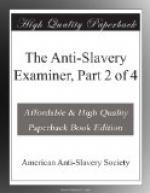be said to have pocketed the seven millions without
having the least claim to them, and therefore,
in considering the proposition he was about to
make, parliament should bear in mind that the slave
proprietors were, if anything, the debtors to
the nation. The money had, in fact, been
paid to them by mistake, and, were the transaction
one between man and man, an action for its recovery
might lie. But the slave-owners alleged that
if the apprenticeship were now done away there
would be a loss, and that to meet that loss they had
a right to the money. For argument’s
sake he would suppose this to be true, and that
there would be loss; but would it not be fair that
the money should be lodged in the hands of a third
party, with authority to pay back at the expiration
of the two years whatever rateable sum the master
could prove himself to have lost? His firm belief
was, that no loss could arise; but, desirous to
meet the planter at every point, he should have
no objection to make terms with him. Let him,
then, pay the money into court, as it were, and
at the end of two years he should be fully indemnified
for any loss he might prove. He called upon
their lordships to look to Antigua and the Bermudas
for proof that the free negro worked well, and
that no loss was occasioned to the planters or
their property by the granting of emancipation.
But it was said that there was a difference between
the cases of Antigua and other colonies, such as
Jamaica, and it was urged that while the negroes
of the former, from the smallness and barrenness
of the place, would be forced into work, that in the
latter they would run away, and take refuge in
the woods. Now, he asked, why should the
negro run away from his work, on being made free,
more than during the continuance of his apprenticeship?
Why, again, should it be supposed that on the
1st of August, 1840, the emancipated negroes should
have less inclination to betake themselves to
the woods than in 1838? If there was a risk of
the slaves running to the woods in 1838, that
risk would be increased and not diminished during
the intermediate period up to 1840, by the treatment
they were receiving from their masters, and the deferring
of their hopes.
My lords, (continued the noble lord,) I have now to say a few words upon the treatment which the slaves have received during the past three years of their apprenticeship, and which, it is alleged, during the next two years is to make them fitted for absolute emancipation. My lords, I am prepared to show that in most respects the treatment the slaves have received since 1834 is no better, and in many others more unjust and worse, than it ever was in the time of absolute slavery. It is true that the use of the cartwhip as a stimulus to labor has been abolished. This, I admit, is a great and most satisfactory improvement; but, in every other particular, the state of the slave, I am prepared to show, is not improved, and, in many respects, it is materially worse. First, with




